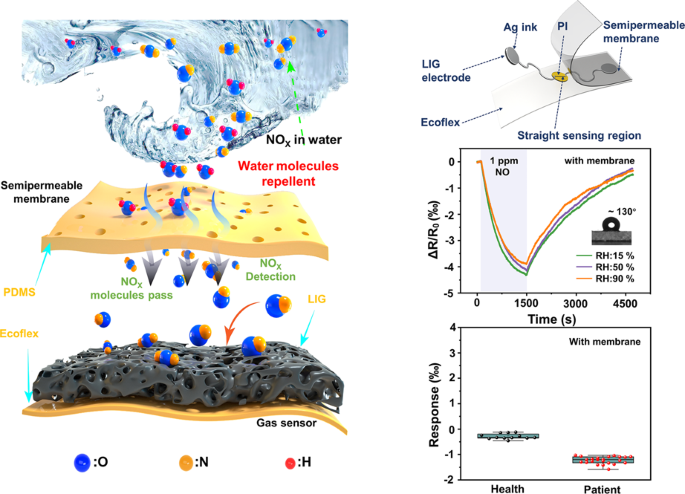2022-08-01 ペンシルベニア州立大学(PennState)
このセンサーは、呼気中の二酸化窒素を検出し、その濃度によって肺疾患の可能性を示唆したり、特定の環境下で空気の質を監視したりすることができる。
研究チームは、レーザー書き込みによって2次元グラフェン層を形成する、レーザー誘起グラフェン(LIG)を使用したLIGセンシング層の両側に、柔らかいエラストマーポリマー基板と耐湿性半透過膜を追加した。
研究者たちは、このセンサーを使って、30人の呼気を評価した。その結果、慢性閉塞性肺疾患(COPD)や喘息を持っている人は、そうでない人に比べてセンサーの反応値が4倍以上大きいことがわかりました。つまり、COPDや喘息の人は呼気中に4倍以上の二酸化窒素を含んでいることがわかった。
<関連情報>
- https://www.psu.edu/news/research/story/new-options-health-environmental-monitoring-water-resistant-gas-sensor/
- https://www.nature.com/articles/s41378-022-00414-x
環境モニタリングや呼気分析のための、レーザー誘起グラフェンを用いた耐湿性・伸縮性NOxガスセンサー Moisture-resistant, stretchable NOx gas sensors based on laser-induced graphene for environmental monitoring and breath analysis
Li Yang,Guanghao Zheng,Yaoqian Cao,Chuizhou Meng,Yuhang Li,Huadong Ji,Xue Chen,Guangyu Niu,Jiayi Yan,Ye Xue & Huanyu Cheng
Microsystems & Nanoengineering Published:08 July 2022
DOI:https://doi.org/10.1038/s41378-022-00414-x

Abstract
The accurate, continuous analysis of healthcare-relevant gases such as nitrogen oxides (NOx) in a humid environment remains elusive for low-cost, stretchable gas sensing devices. This study presents the design and demonstration of a moisture-resistant, stretchable NOx gas sensor based on laser-induced graphene (LIG). Sandwiched between a soft elastomeric substrate and a moisture-resistant semipermeable encapsulant, the LIG sensing and electrode layer is first optimized by tuning laser processing parameters such as power, image density, and defocus distance. The gas sensor, using a needlelike LIG prepared with optimal laser processing parameters, exhibits a large response of 4.18‰ ppm-1 to NO and 6.66‰ ppm-1 to NO2, an ultralow detection limit of 8.3 ppb to NO and 4.0 ppb to NO2, fast response/recovery, and excellent selectivity. The design of a stretchable serpentine structure in the LIG electrode and strain isolation from the stiff island allows the gas sensor to be stretched by 30%. Combined with a moisture-resistant property against a relative humidity of 90%, the reported gas sensor has further been demonstrated to monitor the personal local environment during different times of the day and analyze human breath samples to classify patients with respiratory diseases from healthy volunteers. Moisture-resistant, stretchable NOx gas sensors can expand the capability of wearable devices to detect biomarkers from humans and exposed environments for early disease diagnostics.


